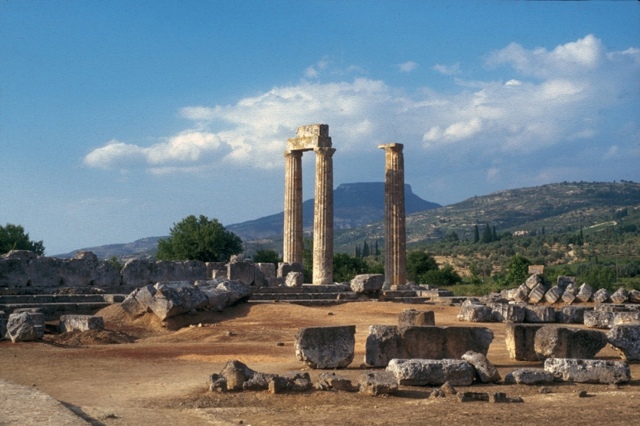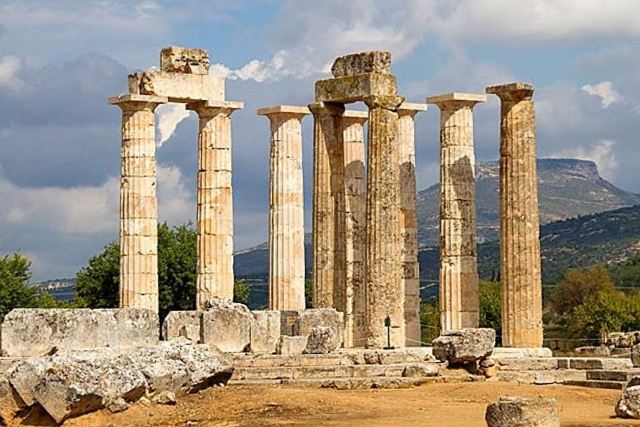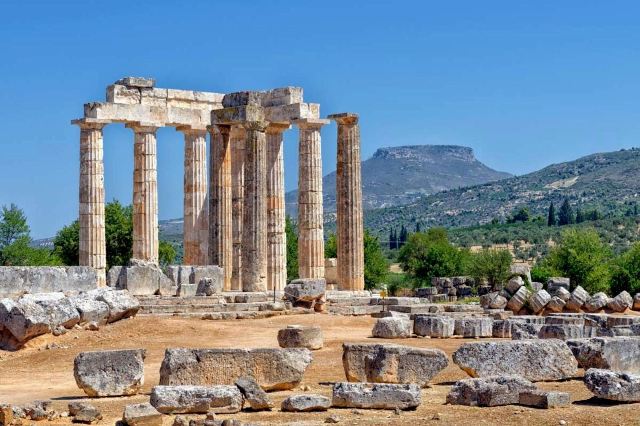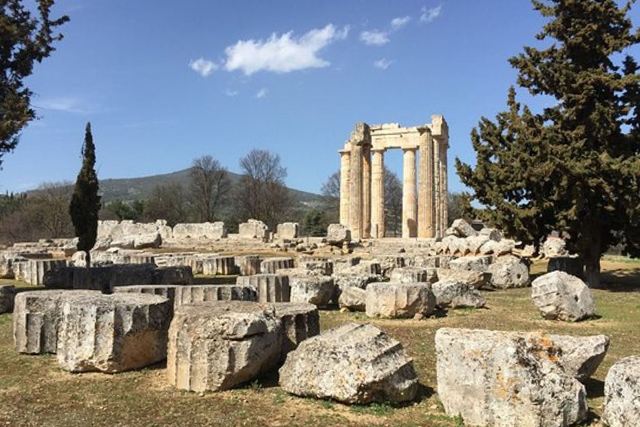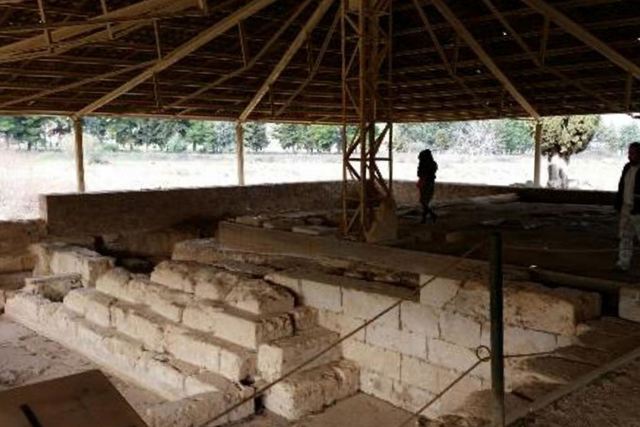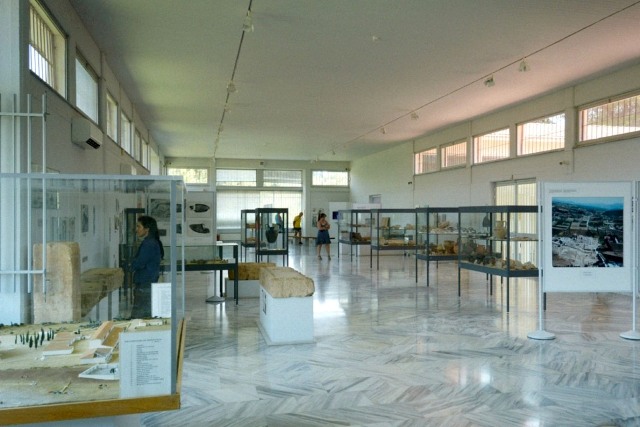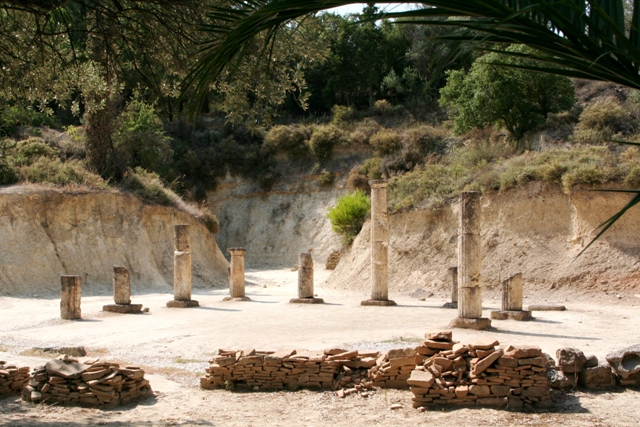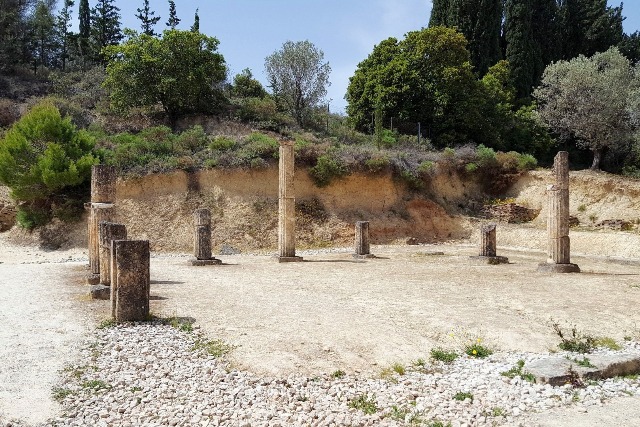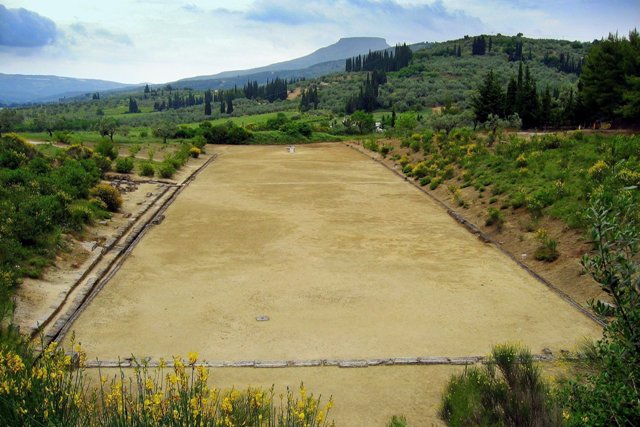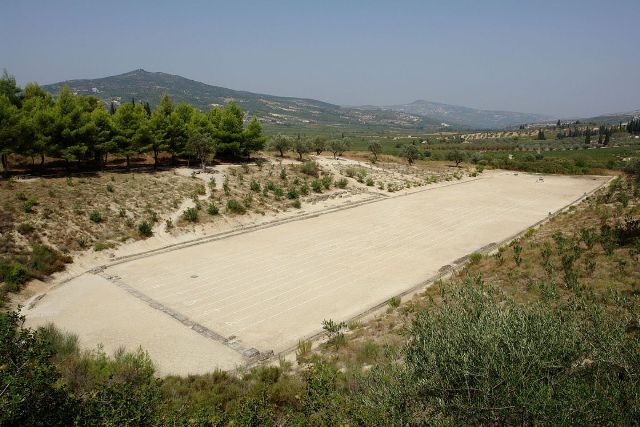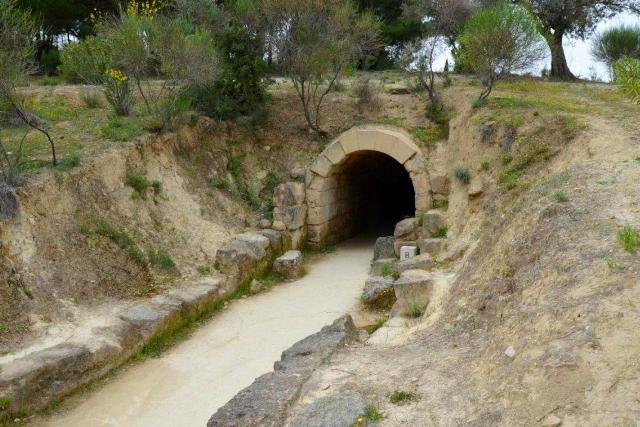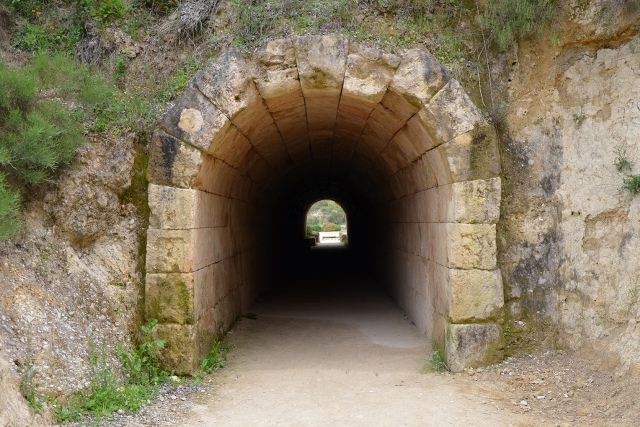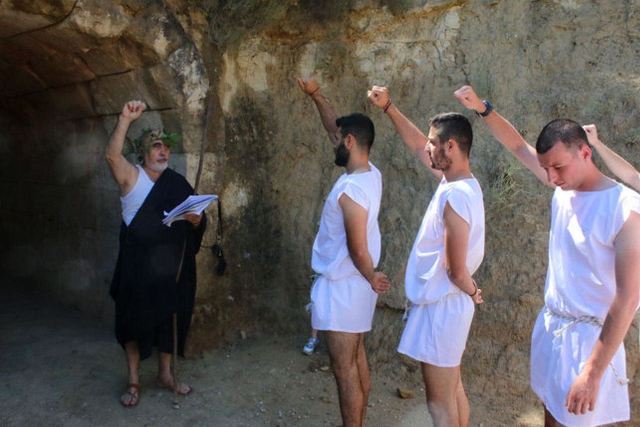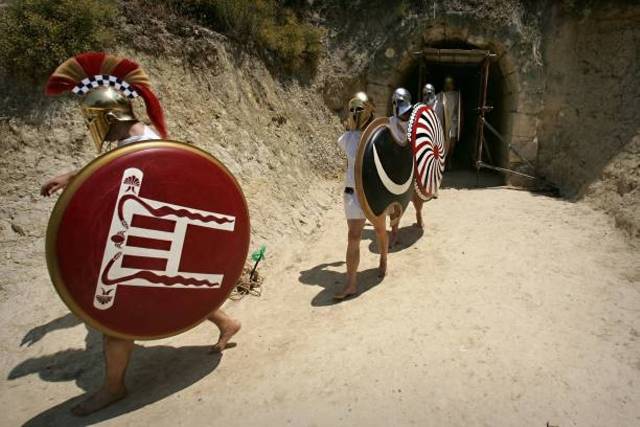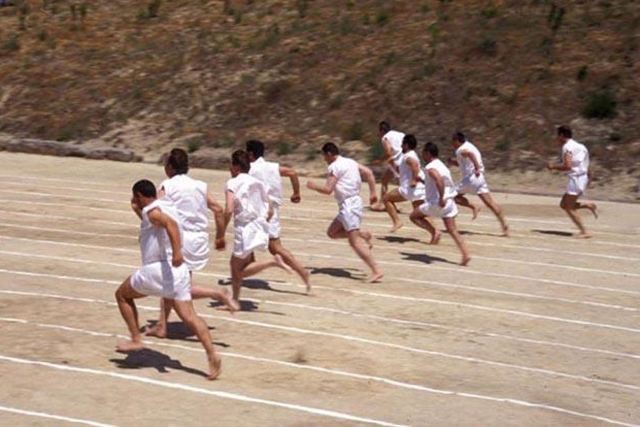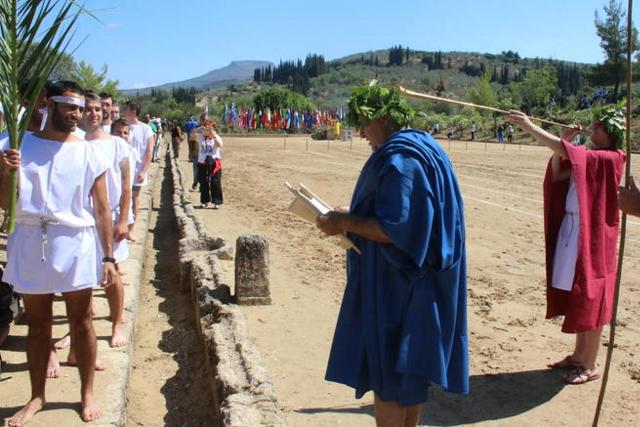Ancient Nemea
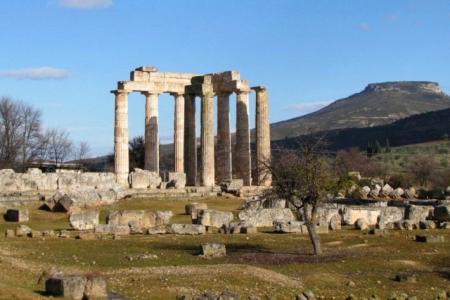 ANCIENT NEMEA - Distance from Ermioni: 104kms/1.7 hrs
ANCIENT NEMEA - Distance from Ermioni: 104kms/1.7 hrs
Nemea is famous in Greek mythology for the place where Heracles slew the ferocious Nemean lion and was one of the four venues that held the Panhellenic Games of ancient Greece, the others being the Olympic Games at Olympia, the Pythian Games at Delphi and the Isthmian Games at Isthmia, near Corinth. The Games at Nemea were established in 573 BC with emphesis on athletic games only, they were held every 2 years and the victors received a crown of wild celery. By the end of the 5th century BC the Sanctuary of Nemean Zeus was destroyed and the Games were transfered to Argos. Following reconstruction, the Games returned to Nemea, however, the Nemean Games finally ended in 271 BC. The Nemean Games were revived in 1996 with many of the ancient events being recreated, apart from clothing being worn, as that all ancient male athletes competed naked.
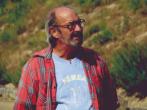
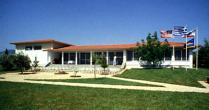 Ancient Nemea was 'rediscovered' in 1973 by Professor Stephen Miller, from the University of California at Berkeley, U.S.A. The present Temple of Nemean Zeus only had 3 columns standing at the time, but over the years, through private donations, Prof. Miller has had a further 6 columns re-erected that we now see. In fact, all the expenses for the work done at Nemea since 1973 have been covered from private donations, mostly from Greek-Americans, the University and various Philhellene donors. These private donations also covered the construction and development of the Archaeological Museum at Nemea, opened in 1984, which houses many of the ancient artefacts found at the site by Professor Miller and his teams. Miller built a home in Nemea with his Greek-American wife, Effie, and even after he officially retired from continually working on the Ancient Nemea site, he used to regularly visit the museum and ongoing archeological work that continues in the area. As recently as 2018, archaeologists have discovered two large intact chamber tombs from the late Mycenaean period, 1400-1200 BC, at the Aidonia cemetery, near Nemea.
Ancient Nemea was 'rediscovered' in 1973 by Professor Stephen Miller, from the University of California at Berkeley, U.S.A. The present Temple of Nemean Zeus only had 3 columns standing at the time, but over the years, through private donations, Prof. Miller has had a further 6 columns re-erected that we now see. In fact, all the expenses for the work done at Nemea since 1973 have been covered from private donations, mostly from Greek-Americans, the University and various Philhellene donors. These private donations also covered the construction and development of the Archaeological Museum at Nemea, opened in 1984, which houses many of the ancient artefacts found at the site by Professor Miller and his teams. Miller built a home in Nemea with his Greek-American wife, Effie, and even after he officially retired from continually working on the Ancient Nemea site, he used to regularly visit the museum and ongoing archeological work that continues in the area. As recently as 2018, archaeologists have discovered two large intact chamber tombs from the late Mycenaean period, 1400-1200 BC, at the Aidonia cemetery, near Nemea.
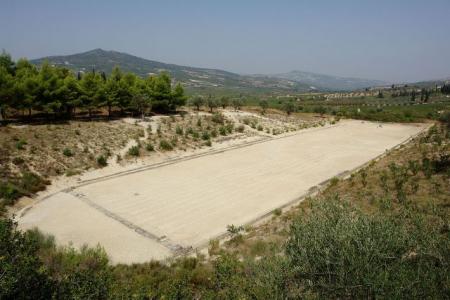 The Nemean Games were held in a classic stadium, a standard 600 ancient foot long (178m) track accommodating over 30,000 spectators, which was discovered by Prof. Miller over 400m from the Sanctuary site. The Stadium was finally cleared and officially opened in July 1994. The ancient Games were usually held soon after the Summer solstice and the athletic events lasted over a number of days. Foot races were of various lengths of the stadium track, including the hoplitodromos which was run in full hoplite armour. Other athletic events included wrestling, boxing and the pentathlon (running-discus-javelin-wrestling-long jump) with horse races also being held, including 2 and 4 horse chariot races. Prior to the construction of the new Temple of Nemean Zeus in 330 BC which we see today, singing, flute and lyre playing competitions were introduced to the Games whilst they were being held in Argos. However, upon their return to Nemea, the events reverted back to the traditional athletic competitions.
The Nemean Games were held in a classic stadium, a standard 600 ancient foot long (178m) track accommodating over 30,000 spectators, which was discovered by Prof. Miller over 400m from the Sanctuary site. The Stadium was finally cleared and officially opened in July 1994. The ancient Games were usually held soon after the Summer solstice and the athletic events lasted over a number of days. Foot races were of various lengths of the stadium track, including the hoplitodromos which was run in full hoplite armour. Other athletic events included wrestling, boxing and the pentathlon (running-discus-javelin-wrestling-long jump) with horse races also being held, including 2 and 4 horse chariot races. Prior to the construction of the new Temple of Nemean Zeus in 330 BC which we see today, singing, flute and lyre playing competitions were introduced to the Games whilst they were being held in Argos. However, upon their return to Nemea, the events reverted back to the traditional athletic competitions.
The Society for the Revival of the Nemean Games was created by Stephen Miller and many of his ancient history enthusiasts. A movement born from over 40 years of excavation at Ancient Nemea and from the enthusiasm and dedication of local residents of Nemea, who felt they could make an important contribution to today's world. In 1996 the first revived Nemean Games were held, 100 years after the Games of I Olympiad in Athens. Following this successful event, they have been held every 4 years since then.
The Stadium of Ancient Nemea reopened to visitors on Wednesday 1st February 2023 after a prolonged period of closure for security reasons. The 4th century BC stadium had been shut down after years of neglect. The effort to reopen it involved the Society for the Revival of Nemean Games, the Nemea Mayor, the Antiquities Ephorate of Corinthia and the Culture Ministry.
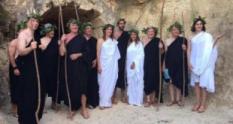 The Archaeological site of Nemea which includes the Temple, Sanctuary and Museum is located close to the small village of Archaia Nemea. Archaia Nemea is situated about 5kms before the new larger modern village of Nemea, where you will find a number of tavernas and cafes. The Stadium lies about 430m East of the Archaeological site and Museum, close to the Apodyterium where the athletes undressed, oiled themselves and prepared for the Games. With the success of the first revived Nemead in 1996, the Games are now held every 4 years. The 'VIII Nemead' Games will be celebrated over the long weekend of 28th to 30th June 2024.
The Archaeological site of Nemea which includes the Temple, Sanctuary and Museum is located close to the small village of Archaia Nemea. Archaia Nemea is situated about 5kms before the new larger modern village of Nemea, where you will find a number of tavernas and cafes. The Stadium lies about 430m East of the Archaeological site and Museum, close to the Apodyterium where the athletes undressed, oiled themselves and prepared for the Games. With the success of the first revived Nemead in 1996, the Games are now held every 4 years. The 'VIII Nemead' Games will be celebrated over the long weekend of 28th to 30th June 2024.
Admission to the Archaeological site, Museum and Stadium: 6 Euros. Open 08:00 - 16:00 every day between April and October. Closed on public holidays. Check before visiting, as the site is sometimes closed during winter months. Tel: +30 27460 22739
In May 2022, the European Commission awarded the archaeological site of Ancient Nemea the European Union's Heritage Label list, taking into consideration its significant role in shaping the history and culture of Europe.
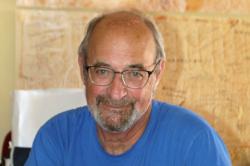 Archaeologist Stephen G. Miller, the father of the Nemean Games Revival, died on Wednesday 11th August 2021. Following five decades of research and excavations, Miller leaves behind a legacy to Greece and the world of the Nemean Games. Recently, his all-too-large heart had been giving him some trouble, he was 79 years old. Stephen directed the excavations of Ancient Nemea from 1973 to 2005, when he finally became a Hellenic citizen. Officially retired from academic duties as an archaeologist, Miller was anything but at rest. He served on the board of the Revival of the Nemean Games Society. Stephen and his wife, Effie, a Greek-American from Utah, built their home in Nemea.
Archaeologist Stephen G. Miller, the father of the Nemean Games Revival, died on Wednesday 11th August 2021. Following five decades of research and excavations, Miller leaves behind a legacy to Greece and the world of the Nemean Games. Recently, his all-too-large heart had been giving him some trouble, he was 79 years old. Stephen directed the excavations of Ancient Nemea from 1973 to 2005, when he finally became a Hellenic citizen. Officially retired from academic duties as an archaeologist, Miller was anything but at rest. He served on the board of the Revival of the Nemean Games Society. Stephen and his wife, Effie, a Greek-American from Utah, built their home in Nemea.
When Stephen Miller was in Nemea, he was at the archaeological site and museum daily. Following the second cancellation of the VII Revival of the Nemean Games due to the global pandemic, Miller said "For more than a quarter century I have had the personal thrill of seeing the ancient Nemian stadium that I discovered, return to life. To see people of of all ages from every corner of the planet, put their bare toes in the ancient starting blocks, to see puffs of dust on the ancient track, to hear the stadium echo with the cheers of hundreds of modern voices, and to see 'ancient' runners in their kitones crowned with wild celery has been gratifying".
In addition to the various 100m track races held within the stadium for athletes of all ages, there is also a long-distance run called 'The Footsteps of Herakles', which is a 7500m race held on the country roads of Nemea and ending back at the historic stadium. Click for more information regarding the XIII Nemean Games to be held on the last weekend in June 2024.
 Nemea is the most important winemaking area of the Peloponnese, with the red Agioritiko being the primary grape being grown in this region. One of the best known wineries in Nemea is Gaia Wines from the small village of Koutsi, near to new Nemea. Other Nemean wineries include Palivos Estate, Domaine Spiropoulis and the Semeli winery. Close to the small village of Archaia Nemea and the Archaeological site there is the Papaioannou Estate winery, Gofas Family winery and the Wine Cooperative of Nemea, all of which welcome their thirsty visitors.
Nemea is the most important winemaking area of the Peloponnese, with the red Agioritiko being the primary grape being grown in this region. One of the best known wineries in Nemea is Gaia Wines from the small village of Koutsi, near to new Nemea. Other Nemean wineries include Palivos Estate, Domaine Spiropoulis and the Semeli winery. Close to the small village of Archaia Nemea and the Archaeological site there is the Papaioannou Estate winery, Gofas Family winery and the Wine Cooperative of Nemea, all of which welcome their thirsty visitors.
Nemea is the largest Protected Designation of Origin (P.D.O.) wine area of Greece, spanning almost 30,000 square kilometres of furtile vineyards. With more than 3,500 years of wine production, Nemea is synonymous with high quality wines and wine culture.
